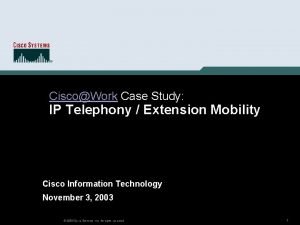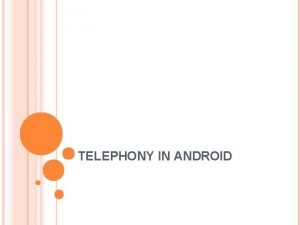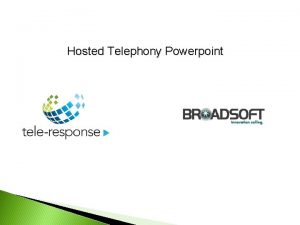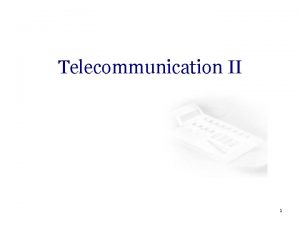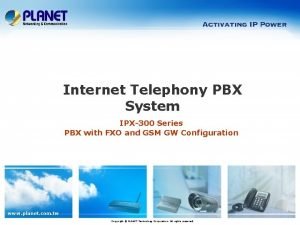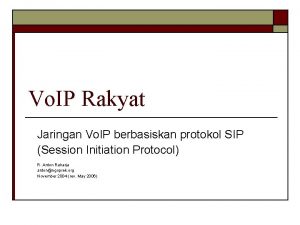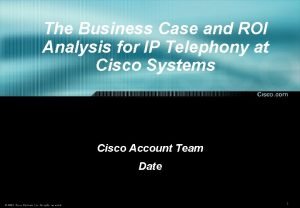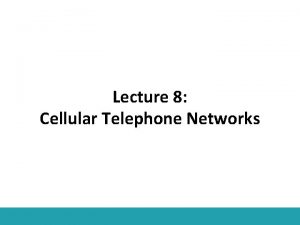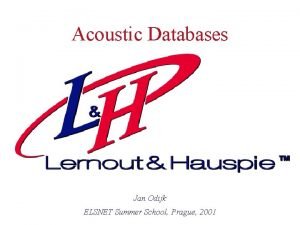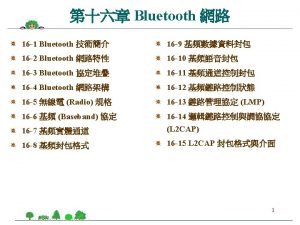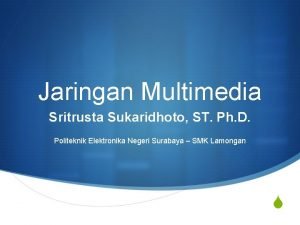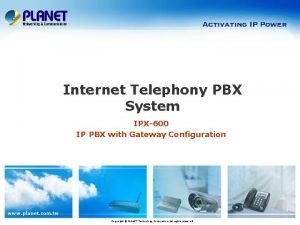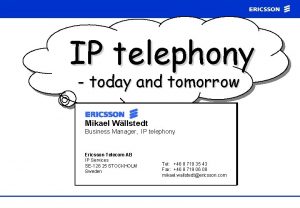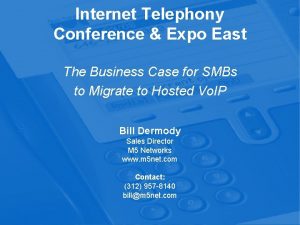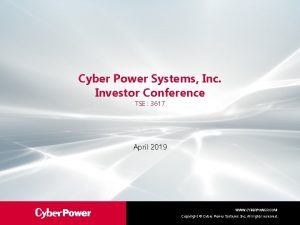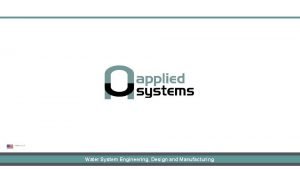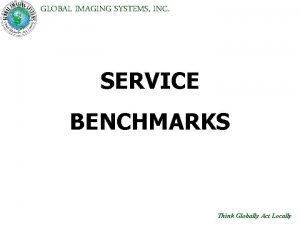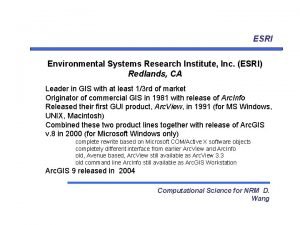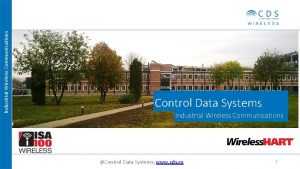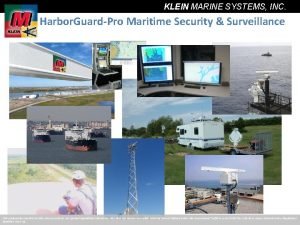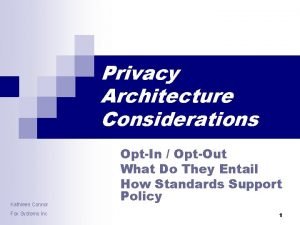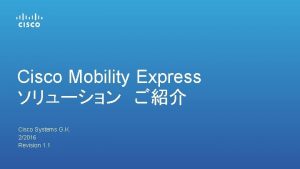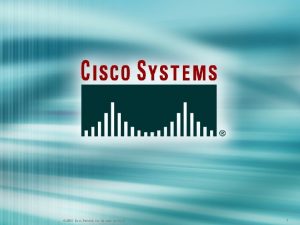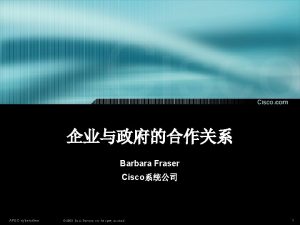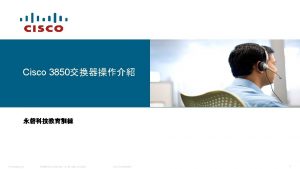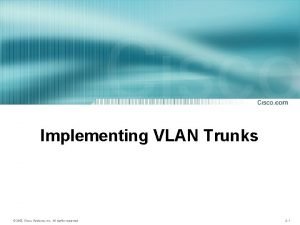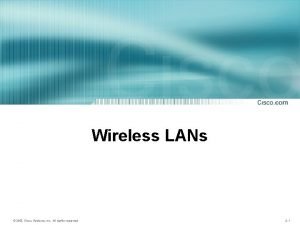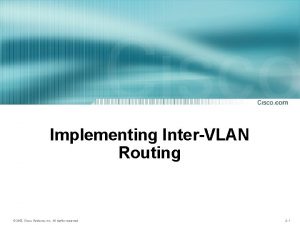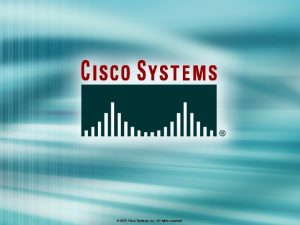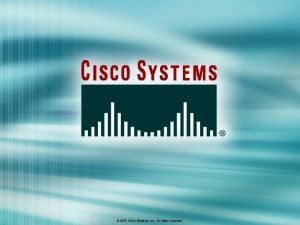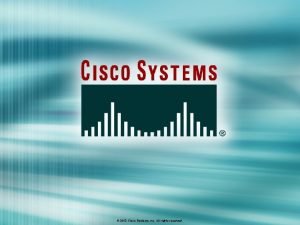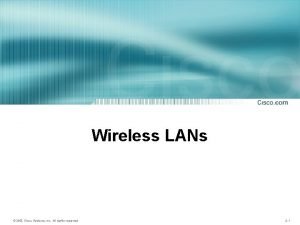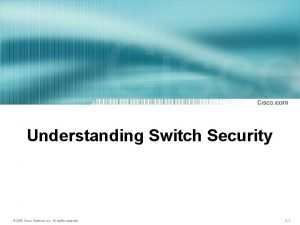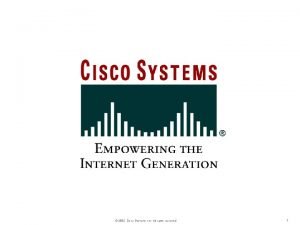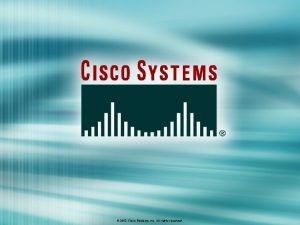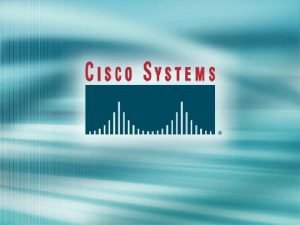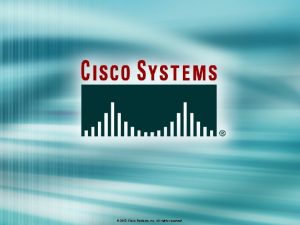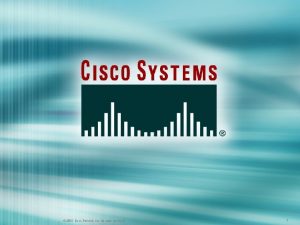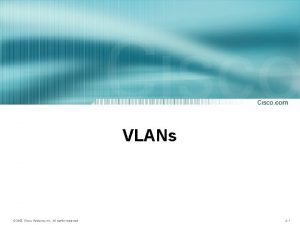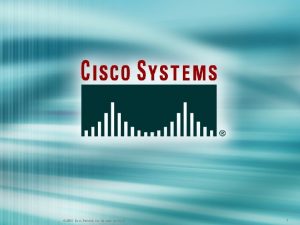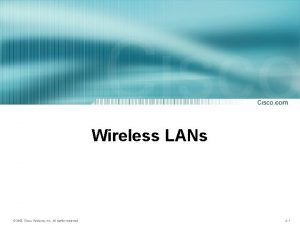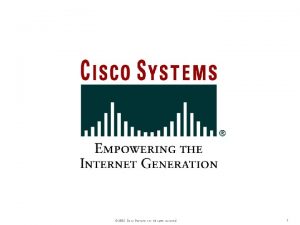Cisco IP Telephony 2003 Cisco Systems Inc All












































- Slides: 44

Cisco IP Telephony © 2003, Cisco Systems, Inc. All rights reserved. 2 -1

TDM PBX Architecture Mainframe cabinet Voice Path (TDM) Proprietary Processor Card(s) Signaling Path Proprietary interface Applications (Voicemail/IVR) Proprietary TDM Switch Card(s) Proprietary interface Proprietary Line Card(s) Proprietary Trunk Card(s) PSTN Proprietary terminals Proprietary interface © 2003, Cisco Systems, Inc. All rights reserved. Standard interface BCMSN v 2. 0— 2 -2

IP PBX Architecture High Availability Server Voice Path (TDM) Call Processing Application Signaling Path Standard Processor Standard OR Proprietary Interface Applications IP TCP/IP Network IP IP phones and PC applications Standard interface © 2003, Cisco Systems, Inc. All rights reserved. IP to PSTN Gateway PSTN Standard interface BCMSN v 2. 0— 2 -3

Practical Example Migration – Before IPC Installation Legacy TDM PBX Inter-site Calls Branch 1 EKTS/ PBX Legacy VM IP WAN Branch 2 EKTS/ PBX V PSTN/DSN Branch (n) EKTS/ PBX Other Apps Server(s) Central Site © 2003, Cisco Systems, Inc. All rights reserved. V BCMSN v 2. 0— 2 -4

Practical Example Migration – After IPC Installation Inter-site Calls Cisco Call. Manager Cluster Branch 1 IP WAN Branch 2 Unified Messaging Server(s) IP-IVR Server(s) Contact Center Server(s) V PSTN/DSN Branch (n) Other Apps Server(s) Central Site © 2003, Cisco Systems, Inc. All rights reserved. V BCMSN v 2. 0— 2 -5

Open Packet Telephony Open Service Application Layer Line Concentration Digital Trunk Subsystem Switching Network TDM/ Circuit Switch (JAIN, TAPI, JTAPI, XML etc. ) Open/Standard Interface Call Control Connection Control Features Common Channel Signaling Complex Open Call Control Layer (SIP, H. 323, MGCP, etc. ) Administration Maintenance Billing Open/Standard Interface Standards-Based Packet Infrastructure Layer (IP, ATM) © 2003, Cisco Systems, Inc. All rights reserved. BCMSN v 2. 0— 2 -6

AVVID Architecture Open Packet Telephony Collaboration Applications Call Processing Cisco Unity Voice Mail, UMS Video Call Processing Voice Portal GK PSTN Infrastructure IP IVR, IP AA Apps Engine Intelligent ICM Contact Manager IP Network Directory • PSTN gateways • Analog phone support • DSP farms Clients IP Soft. Phone © 2003, Cisco Systems, Inc. All rights reserved. The World Is Now Global— All Apps Must Travel Time and Distance BCMSN v 2. 0— 2 -7

Cisco’s Comprehensive Voice Systems Portfolio Call Control BTS 10200 PGW 2200 MCS 7835 2400 -SRST Conference Manager IP Contact Center Personal Assistant Catalyst Switches 4500 Series Endpoints Applications ICS 7750 3550 Series 6500 Series 2950 Series Unified Messaging Gateways AS 5400 7900 Series Soft. Phone © 2003, Cisco Systems, Inc. All rights reserved. ICS 7935 2400/2600/ 3600 Series Catalyst 4200 MGX 8850 BCMSN v 2. 0— 2 -8

Cisco IP Phones and Terminals 7902 7935 7905 7940 7920 7910, 7910 sw © 2003, Cisco Systems, Inc. All rights reserved. VG-248 7960 Softphone 7912 Basic IP Phones ATA 186/188 Mid-range IP Phones Special Function IP Phones Station Gateways BCMSN v 2. 0— 2 -9

Wireless UC 500 installation using SPA 525 G Phones: SPA 525 G Features • The SPA 525 G has a 320 x 240 color, 3. 2" inch LCD screen and provides up to five telephone extensions. • • It provides the following hardware features: • • • Bluetooth capability for headset support • Needs external power supply when not connected to Po. E. 2 Ethernet 10/100 Mbps ports 802. 3 af Power over Ethernet support USB 2. 0 host port for connecting a USB memory device to play MP 3 music files 2. 5 mm stereo earphone jack for headset Wireless-G client support Kensington security slot support Although the Cisco SPA 525 G has an additional Ethernet port that allows a computer to be connected to the network through the IP phone, this option is only available when the phone is connected to the network via the wired Ethernet connection. © 2003, Cisco Systems, Inc. All rights reserved. BCMSN v 2. 0— 2 -10

Wireless UC 500 installation using SPA 525 G Phones: Installation Scenario 1: Small office up to 8 users • • • Scenario 1 is a perfect fit for a small business with up to 8 users who are housed in a single workspace of up to 2, 500 square feet. In this design, a single Cisco UC 500 with an embedded wireless AP is used for both voice and data traffic. Automatic Qo. S settings allow for the coexistence of voice and data on the wireless network, while maintaining voice quality. All 8 users can be engaged in active calls simultaneous with good voice quality. When no calls are present on the system and all phones are in an idle state, computers can take advantage of the full throughput offered by the Wireless-G radio on the built-in UC 500 access point. You do not need to deploy all 8 phones in wireless mode—you can combine wired and wireless phones © 2003, Cisco Systems, Inc. All rights reserved. BCMSN v 2. 0— 2 -11

Wireless UC 500 installation using SPA 525 G Phones: Installation Scenario 2: Small office up to 16 users • • • Scenario 2 is intended for businesses housed in small offices with up to 2, 500 square feet of office space and up to 16 users. This reference design offers a migration path from reference design 1 by adding support for up to 16 wireless phone users and PCs. To migrate from reference design 1 to reference design 2, a business would only need to purchase a single external AP 521 access point and a UC 500 license upgrade to 16 users. The embedded UC 500 access point is used exclusively for data. The external access point is used exclusively for voice. As a result of the physical separation between voice and data achieved by using separate SSIDs on two different physical access points, Qo. S or a wireless LAN controller are not required. © 2003, Cisco Systems, Inc. All rights reserved. BCMSN v 2. 0— 2 -12

Wireless UC 500 installation using SPA 525 G Phones: Installation Scenario 4: Small office up to 16 users • • • Sccenario 4 is intended for businesses housed in larger buildings with up to 10, 000 square feet of office space and 16 users. A 16 user UC 500 SKU is required. Cisco recommends that customers deploying a 24 -user UC 500 hardware platform to provide a more flexible upgrade path. In this design, two external Cisco AP 521 wireless APs are used: one for voice traffic and one for data traffic. Use of separate physical access points for voice and data eliminates the need for a wireless LAN controller (WLC). Note If your office needs more than 16 wireless phones, and you have the license capacity on the UC 500, it is possible to increase the number of wireless phones beyond 16. However, this requires additional access points and a WLC 526 wireless LAN controller for synchronizing SSIDs and security profiles, and is outside the scope of this and the supported reference designs. © 2003, Cisco Systems, Inc. All rights reserved. BCMSN v 2. 0— 2 -13

Vo. IP Signaling Protocols • H. 323 distributed topology networks Call. Manager to Service Providers - ITU standard, ISDN-based, - 90%+ of all Service Provider Vo. IP - The current interconnect for - Useful for video applications • Skinny architecture. - Centralized Call-Control - Call. Manager controls all features. - over 700, 000 IP Phones deployed • MGCP - IETF RFC 2705 - Centralized Call-Control - Call-Agents (MGC) & Gateways Architecture (MG) • SIP - IETF RFC 2543 - Distributed Call-Control - Used for more than Vo. IP…SIMPLE: Instant Messaging / Presence © 2003, Cisco Systems, Inc. All rights reserved. BCMSN v 2. 0— 2 -14

Basic H. 323 Call Gatekeeper A LRQ Gatekeeper B LCF ACF IP Network RRQ/RCF ARQ H. 225 (Q. 931) Setup RRQ/RCF ARQ H. 225 (Q. 931) Alert and Connect H. 245 V Gateway A Phone A © 2003, Cisco Systems, Inc. All rights reserved. RTP V Gateway B Phone B BCMSN v 2. 0— 2 -15

Basic Skinny Call Voice Mail Server Call Setup Ring Back RTP Stream © 2003, Cisco Systems, Inc. All rights reserved. Cisco Call. Manager E. 164 Lookup IP WAN Ring Off Hook H. 323/MGCP Gateway PSTN BCMSN v 2. 0— 2 -16

MGCP Architectures & Mixed Protocols SCP PSTN Gateway. SIP or H. 323 Network BTS / VSC SS 7 P S T N SIP H. 323 IMT GK V PSTN PRI V V Access Gateway MGCP RTP SIP / H. 323 © 2003, Cisco Systems, Inc. All rights reserved. BCMSN v 2. 0— 2 -17

The history of SIP • Session Initiation Protocol (SIP) is defined via RFC 2543 on March 17, 1999. • Additional “feature” drafts have been written to address issues which concern SS 7/ISUP handling, Qo. S, Alerting, DHCP, 3 PCC, Firewalls & NAT, etc… • IETF SIP-WG created in September, 1999 • RFC 2543 bis (additions) created in April 2000. • Vendor interoperability testing done at the semi-annual SIP Bakeoff (8 th in August in UK) © 2003, Cisco Systems, Inc. All rights reserved. BCMSN v 2. 0— 2 -18

SIP Basics - Architecture I N T E LL I G E N T e. Mail LDAP Oracle XML CPL 3 pcc Application Services SIP Proxy, Registrar & Redirect Servers SIP S E R V I C E S SIP SIP User Agents (UA) PSTN CAS or PRI RTP (Media) Legacy PBX © 2003, Cisco Systems, Inc. All rights reserved. BCMSN v 2. 0— 2 -19

SIP Basics - Architectural Elements • Clients: SIP Phones, Softphones, Gateways, Media Gateway Controllers, PDAs, Robots - User Agent Client (UAC) / User Agent Server (UAS) - Originate & Terminate SIP requests • Typically an endpoint will have both UAC & UAS, UAC for originating requests, and UAS for terminating requests • Servers: © 2003, Cisco Systems, Inc. All rights reserved. - Proxy Server - Redirect Server - Registrar Server BCMSN v 2. 0— 2 -20

SIP Servers/Services (cont) Registrar Redirect Location Database SIP Servers/ Services “Where is this name/phone#? ” REGISTER “Here I am” 3 xx Redirection “They moved, try this address” SIP Proxy Proxied INVITE “I’ll handle it for you” INVITE “I want to talk to another UA SIP User Agents © 2003, Cisco Systems, Inc. All rights reserved. SIP User Agents SIP-GW BCMSN v 2. 0— 2 -21

SIP Methods • Consists of Requests and Responses • Requests (unless mentioned, each has a response) • REGISTER: UA registers with Registrar Server • INVITE: request from a UAC to initiate a session • ACK: confirms receipt of a final response to INVITE • BYE: sent by either side to end a call • CANCEL: sent to end a call not yet connected • OPTIONS: sent to query capabilities outside of SDP • Newly Adopted Methods: used to identify device status / SIP IM / Presence (IMPP). “data” in a message body initiate a Transfer carrying “data” for SIP IMPP • Messages contain SIP Headers and Body might be SDP or an attachment or some other application © 2003, Cisco Systems, Inc. All rights reserved. • SUBSCRIBE & NOTIFY: presence. The foundation of • INFO: a means of carrying • REFER: the mechanism to • MESSAGE: the means of BCMSN v 2. 0— 2 -22

SIP Addressing • Modeled after mailto URLs. May be a combination of FQDNs or E. 164 numbers or both. • Support for Fully-Qualified Domain Names (FQDNs) using sip: URLs - sip: “John Doe” <jdoe@cisco. com> • Support for E. 164 addresses sip: 14085551234@gateway. com; user=phone • Support for mixed addresses sip: 14085551234@10. 1. 1. 1; user=phone sip: jdoe@10. 1. 1. 1 • Support for E. 164 addresses using tel: URLs - tel: 14085551234 © 2003, Cisco Systems, Inc. All rights reserved. BCMSN v 2. 0— 2 -23

Basic SIP Call-Flow SIP UA 1 SIP UA 2 INVITE w/ SDP for Media Negotiation 100 Trying 180/183 Ringing w/ SDP for Media Negotiation MEDIA 200 OK ACK MEDIA BYE 200 OK © 2003, Cisco Systems, Inc. All rights reserved. BCMSN v 2. 0— 2 -24

Implementation of Voice in a Campus Network © 2003, Cisco Systems, Inc. All rights reserved. 2 -25

Benefits of a Converged Network • More efficient use of bandwidth and equipment • Lower transmission costs • Consolidated network expenses • Increased revenue from new services • Service innovation • Access to new communications devices • Flexible new pricing structures © 2003, Cisco Systems, Inc. All rights reserved. BCMSN v 2. 0— 2 -26

Describing Vo. IP Network Components © 2003, Cisco Systems, Inc. All rights reserved. BCMSN v 2. 0— 2 -27

Characteristics of Voice and Data © 2003, Cisco Systems, Inc. All rights reserved. BCMSN v 2. 0— 2 -28

Describing Vo. IP Call Flow © 2003, Cisco Systems, Inc. All rights reserved. BCMSN v 2. 0— 2 -29

Auxiliary VLANs • Voice VLANs • 802. 1 p/Q • Port. Fast • A highly available network © 2003, Cisco Systems, Inc. All rights reserved. BCMSN v 2. 0— 2 -30

Qo. S Basics © 2003, Cisco Systems, Inc. All rights reserved. BCMSN v 2. 0— 2 -31

High Availability for Vo. IP • Traditional telephony networks claim 99. 999 percent uptime. • Data networks must consider reliability and availability requirements when incorporating voice. • Methods to improve reliability and availability include: – Redundant hardware – Redundant links – UPS – Proactive network management © 2003, Cisco Systems, Inc. All rights reserved. BCMSN v 2. 0— 2 -32

Power Requirements in Support of Vo. IP • Inline power or power patch panel for IP phones – May require special modules • UPS and generator backup, with autorestart and monitoring • A 4 -hour service-response contract for system problems • Recommended equipment operating temperatures maintained 24/7 Note: There are several power levels defined for Vo. IP, ranging from 4. 0 w to 15. 4 w, depending on the Vo. IP phone used. © 2003, Cisco Systems, Inc. All rights reserved. BCMSN v 2. 0— 2 -33

Summary • Converged networks reduce costs and increase productivity. • Vo. IP equipment consists of a Vo. IP phone and a network infrastructure capable of supporting Vo. IP. • Auxiliary VLANs provide the ability to apply Qo. S to voice traffic without affecting the flow of data from the client PC. • To ensure high quality Vo. IP, implementation of Qo. S is required. • High-availability networks must be created to avoid network congestion and overcome a lack of redundancy and poor engineering. • For ease of implementation, most Vo. IP phones get power through the same cable on which data is sent. This is called “inline power. ” Cisco supports 802. 3 af and its proprietary standard. © 2003, Cisco Systems, Inc. All rights reserved. BCMSN v 2. 0— 2 -34

Configuring Campus Switches to Support Voice • Accommodating Voice Traffic on Campus Switches © 2003, Cisco Systems, Inc. All rights reserved. 2 -35

Qo. S and Voice Traffic in the Campus Model © 2003, Cisco Systems, Inc. All rights reserved. BCMSN v 2. 0— 2 -36

LAN-Based Classification and Marking © 2003, Cisco Systems, Inc. All rights reserved. BCMSN v 2. 0— 2 -37

Layer 2 Marking: 802. 1 p, Co. S • 802. 1 p User Priority field is also called class of service (Co. S). • Different types of traffic are assigned different Co. S values. • Co. S 6 and 7 are reserved for network use. © 2003, Cisco Systems, Inc. All rights reserved. BCMSN v 2. 0— 2 -38

Layer 3 Marking: IP Precedence, DSCP • IPv 4 – Three most significant bits of To. S byte are called IP precedence. – Other bits are unused. • Diff. Serv – Six most significant bits of To. S byte are called Diff. Serv Code Point (DSCP). – DSCP is backward compatible with IP precedence. – Remaining two bits are used for flow control. © 2003, Cisco Systems, Inc. All rights reserved. BCMSN v 2. 0— 2 -39

Classification Tools: Trust Boundaries • A device is “trusted” if it correctly classifies packets. • For scalability, classification should be done as close to the edge as possible. • The outermost trusted devices represent the “trust boundary. ” • 1 and 2 are optimal; 3 is acceptable (if the access switch cannot perform classification). © 2003, Cisco Systems, Inc. All rights reserved. BCMSN v 2. 0— 2 -40

Configuring a Switch for Attachment of a Cisco IP Phone • Voice traffic tagged for voice VLAN • Data VLAN traffic from PC can be – Untrusted – Trusted – Set to a specific value © 2003, Cisco Systems, Inc. All rights reserved. BCMSN v 2. 0— 2 -41

Basic Switch Commands to Support Attachment of a Cisco IP Phone • Configure voice VLAN • switchport voice vlan 110 • Configure trust and Co. S options • mls qos trust cos • mls qos trust device cisco-phone • mls qos extend trust • switchport priority extend cos_value • Verify configuration • show interfaces fa 0/4 switchport • show mls qos interface fa 0/4 © 2003, Cisco Systems, Inc. All rights reserved. BCMSN v 2. 0— 2 -42

Configuration Example • Switch(config)# mls qos • Switch(config)# interface fastethernet 0/4 Switch(config-if)# switchport voice vlan 110 • Switch(config-if)# switchport access vlan 10 • Switch(config-if)# mls qos trust cos Switch(config-if)# mls qos trust device cisco-phone Switch(config-if)# ctrl-Z Switch# show interfaces fastethernet 0/4 Switch# show mls qos interface fastethernet 0/4 Fast. Ethernet 0/4 trust state: trust cos trust mode: trust cos COS override: dis default COS: 0 pass-through: none trust device: cisco-phone © 2003, Cisco Systems, Inc. All rights reserved. BCMSN v 2. 0— 2 -43

© 2003, Cisco Systems, Inc. All rights reserved. BCMSN v 2. 0— 2 -44
 Cisco ip telephony cases
Cisco ip telephony cases 2008 pearson education inc
2008 pearson education inc Name a point that is collinear with the given points
Name a point that is collinear with the given points Telephony service android
Telephony service android Ip telephony ppt
Ip telephony ppt Ip telephony market
Ip telephony market Telephony fundamentals
Telephony fundamentals Ipx300
Ipx300 Internet telephony service provider
Internet telephony service provider Format alamat sip yang benar adalah
Format alamat sip yang benar adalah Ip telephony business case
Ip telephony business case Cellular telephony in computer networks
Cellular telephony in computer networks Telephony
Telephony Baseband and telephony logging
Baseband and telephony logging Telephony
Telephony Ipx-600
Ipx-600 Manfaat internet bagi sekretaris
Manfaat internet bagi sekretaris Ip telephony business case
Ip telephony business case Ip telephony business case
Ip telephony business case Internet telephony gateway
Internet telephony gateway Travel document systems inc
Travel document systems inc Opw fms
Opw fms Cyber power solutions
Cyber power solutions Applied systems inc subsidiaries
Applied systems inc subsidiaries Uticom systems inc
Uticom systems inc Global imaging systems inc
Global imaging systems inc Environmental systems research institute inc
Environmental systems research institute inc Multiplex systems inc
Multiplex systems inc Preferred systems inc
Preferred systems inc Control data systems inc
Control data systems inc Educational data systems inc
Educational data systems inc Marine fluid systems
Marine fluid systems Oli systems
Oli systems Harbor marine systems inc
Harbor marine systems inc Diversified air systems inc
Diversified air systems inc Fox systems inc
Fox systems inc Advanced cooling systems inc
Advanced cooling systems inc 2012 pearson education inc
2012 pearson education inc Pearson education inc. all rights reserved
Pearson education inc. all rights reserved 2010 pearson education inc
2010 pearson education inc Pearson education inc all rights reserved
Pearson education inc all rights reserved 2010 pearson education inc
2010 pearson education inc Mobility express
Mobility express Decision support systems and intelligent systems
Decision support systems and intelligent systems Engineering elegant systems: theory of systems engineering
Engineering elegant systems: theory of systems engineering
